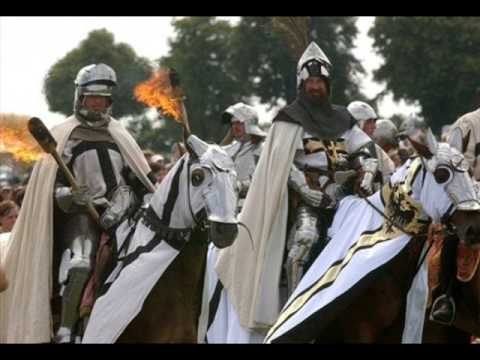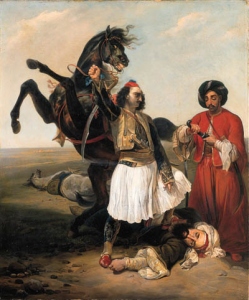
February 25th is the anniversary of the 1336AD mass suicide at Pilénai, a hill fort in Lithuania, where 4,000 brave defenders took their own lives rather than surrender to the Teutonic Knights. Balderdash! But let me explain why.
When you mention the Crusades most people default to Outremer, the Holy Land, where the Templar and Hospitaller orders maintained a strong presence. But there were other Crusades and other orders. Spain had the reconquista and the Knights of Calatrava and it was accorded the same conditions by the Pope as service in Jerusalem. You could win indulgences, shrive yourself of sins, and even clear your debts. The siege of Lisbon in Portugal was one of the few Christian victories of the second crusade. In Germany the Teutonic Order secured crusader terms and conditions for their conversion (at the point of a sword) of the pagan peoples of the region that now constitutes Prussia/Poland, Estonia, Latvia and Lithuania.
It is called the Northern Crusades, and ran from the Wendish Crusade in 1147 until it fizzled out in the early 15th Century as it dawned on the religious leaders that the Catholic/Roman Christians such as the Teutonic and Livonian orders were fighting Orthodox Russian Christians of the church in Constantinople rather than pagans. The “crusades” had become a massive land grab as the Germans and Russians grasped their opportunities to expand into the region. Further North the Swedes saw the way the wind was blowing and conquered large sections of what is now Finland. The Northern Crusades gave way to the Northern Wars between Prussia, Denmark, Poland, Lithuania, Sweden and Russia.
In most of Europe war is a summertime affair. Grass is the fuel for horses and large cavalry armies were only able to campaign when the grass was plentiful. Snow and ice in the winter made it difficult to move and most armies hunkered down in the cold of winter. Spring and autumn rains turned roadways into a sea of mud, and farmers were needed for spring planting and autumn harvest, so wars were fought in summer.
War in the Baltic states was a bit different. The Romans never stretched their influence into these lands so they were devoid of straight roads. Moving about was difficult in the Summertime. Strangely enough it was the winter when travel was easiest. The many lakes, rivers and streams of the baltic region freeze solid in winter. In the process they become flat highways that facilitate travel by a cavalry army as long as you have crampons on your horseshoes.
So it was in February of 1336 in the winter campaign season when the Teutonic order moved in force against the Grand Duchy of Lithuania. When the powerful Teutonic army was spotted the people of the region fled to the hillfort at Pilénai. The Duke, Margiris, attempted to rally his forces but he was quickly over-run. It is at this stage the legend becomes divorced from reality.
The legend is that the stout hearted Lithuanians, seeing they had no hope, bravely committed mass suicide, thus denying the hated Germans booty or slaves. This is a founding legend of the Lithuanian people. There is nothing like a great massacre or sacrifice to build national pride. The Jews did it at Masada. In India the British gifted them the Amritsar massacre. Ireland has two Bloody Sundays, one in Dublin in 1921 and one in Derry in 1972.
I say the legend of Pilénai is balderdash because it was not Jonestown in Guyana where Jim Jones calmly lined up his followers and dispensed cyanide in Koolaid. Pilénai was undoubtedly a scene of chaos. Frightened peasants scrambling up the hill from all sides pursued by the Teutonic soldiers. When they saw the scene anyone with a horse tried to escape. Margiris attempted to establish a cordon but the attacking troops hurled stones and flaming brands into the defensive lines.
Instead of the defenders deciding to burn their property to deny it to the attackers the fires were probably started by the attackers. The defenders may have thrown the peasants belongings into fires as a means of keeping the Teutonics at bay. What we know is that many peasants and very few soldiers found themselves trapped by a powerful German army on a hillfort from which they could not escape. The peasants came from four different regions and were in no way a united people. Some may have committed suicide. Some died defending the hill. Some were captured and taken prisoner.
But that will not do for a national legend. The 4,000 men, women and children were transformed into 4,000 brave Lithuanian soldiers. The chaos was transformed into resolve and decision. The agency for the victory was stripped from the Teutonic knights and the Lithuanians were celebrated for their sacrifice. This is how legends are born.
The nationalist Irish song below, written in 1844 evokes the suicidal defense of Thermopylae by the 300 Spartans, and the three Romans who defended the Pons Sublicius; Spurius Lartius, Titus Herminius and Horatius Cocles. It conjures up the old pagan belief that an act of human sacrifice can win the favour of the Gods.
A Nation once again; by Thomas Osborne Davis
When boyhood’s fire was in my blood
I read of ancient freemen.
For Greece and Rome who bravely stood,
three hundred men and three men.
And there I prayed I yet might see
our fetters rent in twain
and Ireland, long a province be
a nation once again.
It whisper’d too, that freedom’s ark
and service high and holy
would be prepared by feelings dark
and passion vain or lowly.
For freedom comes from God’s right hand
and needs a godly train
and righteous men must make our land
a nation once again.
So as I grew from boy to man
I bent me to that bidding.
My spirit of each selfish plan
and cruel passion ridding.
For thus I hoped some day to aid
oh, can such hope be vain
when my dear country should be made
a nation once again.
A nation once again,
a nation once again,
and Ireland, long a province be
a nation once again!
-=o0o=-
This site is available for free and I make no money from any ads you see here. If you would like to show your appreciation feel free to leave a comment or you can buy me a coffee! http://buymeacoffee.com/DonalClancy

